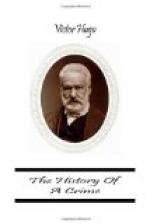“Go at once and inform the other Representatives,” said I.
He left me.
CHAPTER III.
WHAT HAD HAPPENED DURING THE NIGHT
Previous to the fatal days of June, 1848, the esplanade of the Invalides was divided into eight huge grass plots, surrounded by wooden railings and enclosed between two groves of trees, separated by a street running perpendicularly to the front of the Invalides. This street was traversed by three streets running parallel to the Seine. There were large lawns upon which children were wont to play. The centre of the eight grass plots was marred by a pedestal which under the Empire had borne the bronze lion of St. Mark, which had been brought from Venice; under the Restoration a white marble statue of Louis XVIII.; and under Louis Philippe a plaster bust of Lafayette. Owing to the Palace of the Constituent Assembly having been nearly seized by a crowd of insurgents on the 22d of June, 1848, and there being no barracks in the neighborhood, General Cavaignac had constructed at three hundred paces from the Legislative Palace, on the grass plots of the Invalides, several rows of long huts, under which the grass was hidden. These huts, where three or four thousand men could be accommodated, lodged the troops specially appointed to keep watch over the National Assembly.
On the 1st December, 1851, the two regiments hutted on the Esplanade were the 6th and the 42d Regiments of the Line, the 6th commanded by Colonel Garderens de Boisse, who was famous before the Second of December, the 42d by Colonel Espinasse, who became famous since that date.
The ordinary night-guard of the Palace of the Assembly was composed of a battalion of Infantry and of thirty artillerymen, with a captain. The Minister of War, in addition, sent several troopers for orderly service. Two mortars and six pieces of cannon, with their ammunition wagons, were ranged in a little square courtyard situated on the right of the Cour d’Honneur, and which was called the Cour des Canons. The Major, the military commandant of the Palace, was placed under the immediate control of the Questors.[2] At nightfall the gratings and the doors were secured, sentinels were posted, instructions were issued to the sentries, and the Palace was closed like a fortress. The password was the same as in the Place de Paris.
The special instructions drawn up by the Questors prohibited the entrance of any armed force other than the regiment on duty.
On the night of the 1st and 2d of December the Legislative Palace was guarded by a battalion of the 42d.




